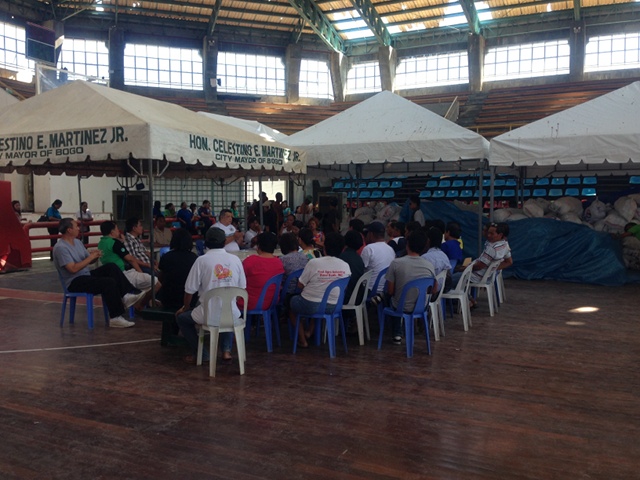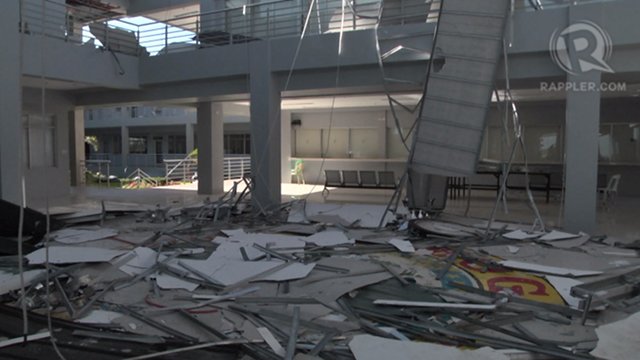SUMMARY
This is AI generated summarization, which may have errors. For context, always refer to the full article.

BOGO CITY, Philippines – “Walay pabor-pabor. Hatag sa tanan. Lihok.” (No favoritism. Give to all. Move.)
With this marching order, Bogo City Mayor Celestino “Junie” Martinez Jr dismissed his meeting with barangay (village) captains at a sports complex, the base for relief operations in this northern Cebu city reeling from Super Typhoon Yolanda (Haiyan).
Named after the mayor’s father, the Don Celestino Martinez Coliseum is not just the drop-off point for aid. It is where officials now work after Haiyan brought down the newly built city hall’s ceiling, roof and windows.
Known as the center for trade and commerce in northern Cebu, Bogo City is now grappling with the lack of electricity, damaged schools and hospitals, and homelessness for 90% of its people. The city is home to over 80,000 residents. Thirteen died in Bogo, among the over 4,000 fatalities in central Philippines.
Yet city employees and authorities are making do and getting organized. On blackboards, they keep track of the casualties, damages, and aid trickling in to the 29 barangays. They are determined not to make their community helpless.
“We are relying on donations but it’s not a total doleout. Starting Monday, the city government is employing 100 people per barangay. We call it cash for work. We pay them and then they have to clean up the city,” Martinez told Rappler on Monday, November 18.
“After this, we go for food for work. We give them food and then we let them work on their houses, maybe fix, clean their houses for another week.”
While focused on recovery, Martinez said that the city must learn from its experience with Haiyan. At the height of the world’s most powerful storm on November 8, city buses had to pick up residents who refused to heed the call for preemptive evacuation.
“We have never experienced any calamity here, never. Since this doesn’t happen to us, we took it very lightly,” the mayor admitted. “The people relied so much on our patron saint. Our patron saint is very miraculous but things like this really happen so I hope this time, they will not be overconfident.”
Martinez was referring to Saint Vincent Ferrer. Incidentally, he is the patron saint of what the residents must now be: builders and construction workers.

‘Hunger, difficulty, crisis’
Among those who decided to brave the typhoon in their homes is Naome Cantay. She and her children prayed hard as the wind blew the roof of their house away.
“Malipayon mi kay buhi gihapon mi. Kana akong pasalamat na dako sa Ginoo. Ang Ginoo gyud nagmilagro na sa amoa.” (We are happy we are still alive. That is what I thank God for. The Lord really gave us a miracle.)
Cantay said relief goods began reaching her barangay in Odlot but it is not enough for everyone. People’s food source is gone.
“Ang among mga saging, tanan lubi, dako nga damage gyud kay murag gi-ibot ang among lubi, ang among mga mais. Dako gyud na gutom. Gutom, kalisod, krisis, mo among giatubang,” she said.
(Our bananas, all the coconuts are damaged because they were uprooted. All our corn, too. This will cause great hunger. Hunger, difficulty, crisis. That is what we face here.)
The city’s main source of livelihood is agriculture, particularly sugar. Martinez admitted he has no prompt solution, with the extent of the damage from Haiyan. He said he will meet with the Department of Agriculture to discuss aid for the farmers.
Yet the biggest problem is shelter. Despite the food for work program, residents can only repair their typhoon-hit homes so much.
Martinez said the plan is to design a house worth P35,000 using materials donated by organizations and corporations, and money from the national government.
“They have pledged to give us building materials: GI sheets, cement. We will build a house for those who became homeless but we will not give it to them for free. We will give it amortized by these people at a very low amount. Maybe P100 or P120 monthly amortization payable in 20 years. I discussed it with the barangay captains and they are happy because it is affordable,” Martinez said.
“It is a decent house. It has a kitchen, a toilet and their room. We’re making a design and we will present it to corporations and maybe the National Housing Authority,” he added.

‘After Holocaust, we came to help others’
It is not just the national government and corporations lending a hand to Bogo City. Just a 5-minute walk from the sports complex-turned-relief center is the field hospital of the Israeli Defense Forces (IDF).
Right in front of the Severo Verallo Memorial District Hospital are green tents where Israeli doctors offer medical services like clockwork. Cantay and other Bogo City residents line up for hours to get treatment but they are not disappointed.
The IDF brought in 150 medical experts who have been providing services ranging from treating infected wounds from the typhoon, to tending to injuries from road accidents, to removing a cancerous tumor from a woman’s breast.
Just two hours after the IDF set camp on November 15, the first baby was born in the hospital. The parents named him Israel in gratitude for the assistance. In its first 3 days in Bogo, the IDF field hospital was able to treat 700 patients.
Israeli Embassy Deputy Chief of Mission Adam Michael Levene said the IDF humanitarian mission is set to run for two to 3 weeks, depending on the request of the Philippine government and the assessment of the team.
Besides medical aid, the IDF has civil and engineering teams helping rebuild damaged hospitals and schools in northern Cebu.
Levene told Rappler the rehabilitation is bound to be a long process but the Israeli experts are trying to help the residents move forward, especially the children.
“We also have psychiatrists, psychologists working on this. If someone loses a loved one, there’s emotional damage but don’t forget as well that for little kids, when their classroom’s destroyed and their house is ripped to pieces, even if they’re very, very small, it affects them. It’s important. Maybe little kids don’t always know how to say it but it’s there,” he said.
Asked why Israel was one of the first countries that came to the Philippines’ aid, Levene pointed to his country’s history.
“Our people went through the Holocaust and the question we asked ourselves was, ‘Where were other people? Where were other people’s responsibility as human beings when tragedy occurs?’”
“We came out of that and since then until now, we know that we have to help other people in the world.” – Rappler.com

Add a comment
How does this make you feel?
There are no comments yet. Add your comment to start the conversation.